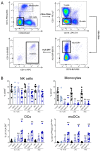Examination of Novel Immunomodulatory Effects of L-Sulforaphane
- PMID: 33673203
- PMCID: PMC7917832
- DOI: 10.3390/nu13020602
Examination of Novel Immunomodulatory Effects of L-Sulforaphane
Abstract
The dietary isothiocyanate L-sulforaphane (LSF), derived from cruciferous vegetables, is reported to have several beneficial biological properties, including anti-inflammatory and immunomodulatory effects. However, there is limited data on how LSF modulates these effects in human immune cells. The present study was designed to investigate the immunomodulatory effects of LSF (10 µM and 50 µM) on peripheral blood mononuclear cell (PBMC) populations and cytokine secretion in healthy adult volunteers (n = 14), in the presence or absence of bacterial (lipopolysaccharide) and viral (imiquimod) toll-like receptor (TLRs) stimulations. Here, we found that LSF reduced pro-inflammatory cytokines interleukin (IL)-6, IL-1β, and chemokines monocyte chemoattractant protein (MCP)-1 irrespective of TLR stimulations. This result was associated with LSF significantly reducing the proportion of natural killer (NK) cells and monocytes while increasing the proportions of dendritic cells (DCs), T cells and B cells. We found a novel effect of LSF in relation to reducing cluster of differentiation (CD) 14+ monocytes while simultaneously increasing monocyte-derived DCs (moDCs: lineage-Human Leukocyte Antigen-DR isotype (HLA-DR)+CD11blow-high CD11chigh). LSF was also shown to induce a 3.9-fold increase in the antioxidant response element (ARE) activity in a human monocyte cell line (THP-1). Our results provide important insights into the immunomodulatory effects of LSF, showing in human PBMCs an ability to drive differentiation of monocytes towards an immature monocyte-derived dendritic cell phenotype with potentially important biological functions. These findings provide insights into the potential role of LSF as a novel immunomodulatory drug candidate and supports the need for further preclinical and phase I clinical studies.
Keywords: L-sulforaphane; anti-inflammatory effects; cruciferous vegetables; dendritic cells; immune cells; immunomodulatory effects; monocytes.
Conflict of interest statement
The authors declare no conflict of interest.
Figures


 10 µM LSF,
10 µM LSF, 
 10 µM LSF,
10 µM LSF, 
 10 µM LSF,
10 µM LSF, 
 10 µM LSF,
10 µM LSF, 

 10 µM LSF,
10 µM LSF, Similar articles
-
Suppression of LPS-induced transcription and cytokine secretion by the dietary isothiocyanate sulforaphane.Mol Nutr Food Res. 2014 Dec;58(12):2286-96. doi: 10.1002/mnfr.201400550. Epub 2014 Oct 27. Mol Nutr Food Res. 2014. PMID: 25284333
-
Sulforaphane Reduces the Chronic Inflammatory Immune Response of Human Dendritic Cells.Nutrients. 2023 Jul 31;15(15):3405. doi: 10.3390/nu15153405. Nutrients. 2023. PMID: 37571342 Free PMC article.
-
Immunomodulatory dendritic cells generated from nonfractionated bulk peripheral blood mononuclear cell cultures induce growth of cytotoxic T cells against renal cell carcinoma.J Immunother. 2000 Jan;23(1):83-93. doi: 10.1097/00002371-200001000-00011. J Immunother. 2000. PMID: 10687141
-
Monocytes and dendritic cells in a hypoxic environment: Spotlights on chemotaxis and migration.Immunobiology. 2008;213(9-10):733-49. doi: 10.1016/j.imbio.2008.07.031. Epub 2008 Sep 21. Immunobiology. 2008. PMID: 18926289 Review.
-
The potential use of l-sulforaphane for the treatment of chronic inflammatory diseases: A review of the clinical evidence.Clin Nutr. 2020 Mar;39(3):664-675. doi: 10.1016/j.clnu.2019.03.022. Epub 2019 Mar 25. Clin Nutr. 2020. PMID: 30954362 Review.
Cited by
-
Anti-Inflammatory Therapeutic Mechanisms of Isothiocyanates: Insights from Sulforaphane.Biomedicines. 2024 May 24;12(6):1169. doi: 10.3390/biomedicines12061169. Biomedicines. 2024. PMID: 38927376 Free PMC article. Review.
-
SFX-01 in hospitalised patients with community-acquired pneumonia during the COVID-19 pandemic: a double-blind, randomised, placebo-controlled trial.ERJ Open Res. 2024 Mar 11;10(2):00917-2023. doi: 10.1183/23120541.00917-2023. eCollection 2024 Mar. ERJ Open Res. 2024. PMID: 38469377 Free PMC article.
-
Sulforaphane prevents and reverses allergic airways disease in mice via anti-inflammatory, antioxidant, and epigenetic mechanisms.Cell Mol Life Sci. 2022 Nov 1;79(11):579. doi: 10.1007/s00018-022-04609-3. Cell Mol Life Sci. 2022. PMID: 36319916 Free PMC article.
-
Sulforaphane Impact on Reactive Oxygen Species (ROS) in Bladder Carcinoma.Int J Mol Sci. 2021 May 31;22(11):5938. doi: 10.3390/ijms22115938. Int J Mol Sci. 2021. PMID: 34073079 Free PMC article. Review.
-
Immunomodulatory Effects of (R)-Sulforaphane on LPS-Activated Murine Immune Cells: Molecular Signaling Pathways and Epigenetic Changes in Histone Markers.Pharmaceuticals (Basel). 2022 Aug 4;15(8):966. doi: 10.3390/ph15080966. Pharmaceuticals (Basel). 2022. PMID: 36015113 Free PMC article.
References
MeSH terms
Substances
LinkOut - more resources
Full Text Sources
Other Literature Sources
Research Materials
Miscellaneous

